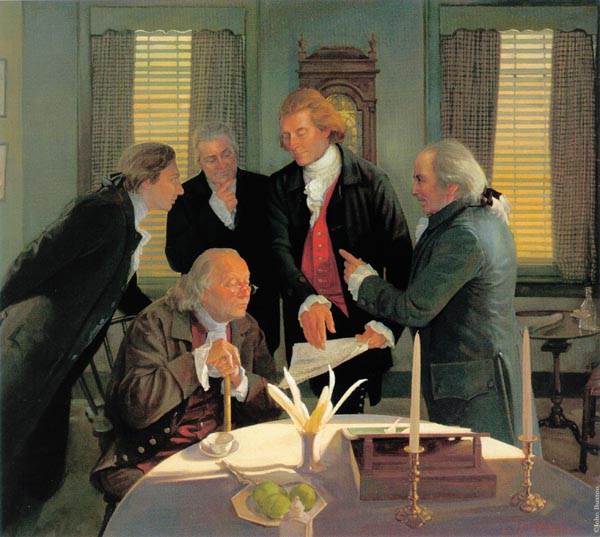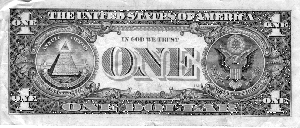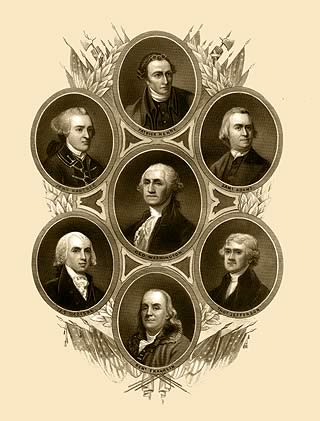|
The Great Seal of the USA The Masonic View |
||
| "American Masons first met in 1720 in Boston. Within
half a century Freemasons were meeting in the lodge rooms of Boston and
at the Green Dragon Tavern there, plotting the overthrow of the British
colonial authorities." - Jed Stevenson
"While many non-Masons were also involved, Masonic
historians say that three of the best-known firebrands - Peter Faneuil,
Paul Revere and John Hancock - were Masons." - Jed Stevenson
|
||
|
Editor's Note: Not long ago a brother Mason called and asked if I had any information on the Masonic connection between Masonry and the Great Seal of the United States. I informed him that I did not, but I would check my files and would share with him whatever I found. I subsequently sent him the story written by Jed Stevenson.. Since then, I unearthed the story written by Betty Womack Sudduck. Both are printed herein. Are these mysterious symbols on a dollar bill borrowed from the Freemasons? You decide.. The Meaning of the Great SealBy Betty Womack Sudduth Some people argue that because many Revolutionary leaders were Freemasons,
the great seal may include Masonic symbols.
What do most of us use daily, never seem to have enough of and yet
never really look at? The U.S. one-dollar bill. Its green back is the prominent
place of display for the Great Seal of the United States, designed by secretary
of the Congress Charles Thomson and adopted by Congress June 20, 1782,
the same day Thomson's design was submitted.
The great Seal, more than any other ensign used by the United States, represents what the country, ideally should be. Although each part of it has a symbolic meaning few know what those symbols represent. The central figure of the seal's face is the eagle. Although many nations or Governments use the eagle in their symbolism, our bald eagle is unique in that it is native only to North America. Always representative of freedom of spirit and the human soul, the eagle is shown in a "rising" position with its wings spread. In its beak is a scroll bearing the Latin inscription "E. Pluribus Unum;' or "One (nation) out of many (states)," representative of the unity of the nation's individuals. In the eagle's left talon are 13 arrows, representing the strength and power of the original 13 colonies, and in its right is all olive branch bearing 13 leaves, representing the desire for peace. The symbolism is that although the eagle prefers to live in peace, it can wage war. The shield of defense, or escutcheon, on the eagle's usually vulnerable breast bears 13 stripes unified under a field, or chief," of blue. The 13 vertical stripes came from the flag of 1777. In 1782, the blue chief above the stripes symbolized Congress, but since 1789, it has stood for all branches of the U.S. government. Above the eagle's is "a radiant constellation of 13 stars," still Symbolizing the original states. These are arrived in the Star of David pattern, symbolic in the Jewish faith of spiritual and material balance. 'this "new constellation" of the 1777 flag is enclosed in a "glory" or golden radiance, breaking through the cloud. On the reverse of the seal is a pyramid of 13 levels or courses of stone, representing the Union and symbolizing political strength, human attributes and divine origin. Above it, as the Keystone, is the Eye of Providence enclosed in its traditional triangle. The Roman numerals on the pyramid stand for -1776, birth date of the United States. Above the pyramid is the Latin phrase "Annuit Coeptis," meaning "a bold beginning" or "He (God) has approved our undertakings," adopted from Virgil's Aeneid. Below the pyramid is another Latin phrase, "Novus Ordo Seclorum," meaning "a new order of the ages," from Virgil's Eclogues, representative of the separation of church and state. The Founding Fathers had in mind a social order that would guarantee the individual political and personal freedom under the law. By Betty Womack Sudduth -reprinted from Sunday Magazine - August
30, 1987, Baton Rouge, LA.
The Meaning of the Great Seal Dollar bills come and go so quickly that hardly anyone ever thinks of the strange design on the back:: the great seal of the United States, with its bristling eagle, strange pyramid and hovering eye. Who would take the time, buying a cup of coffee or an ice cream cone, to consider the mystery of these symbols, which change hands countless times every day? Over the years many attempts have been made to give a reason for the presence of the symbols on the seal and the bill. One explanation is that many leaders of the American Revolution were Freemasons, and that the group's symbols might therefore have found their way into symbols of the emerging nation. That is by no means the accepted explanation. In "The Eagle and Shield: a History of the Great Seal of the United States," a 1976 State Department publication, Richard S. Patterson and Richardson Dougall argue that, "It seems likely the designers of the Great Seal and the Masons took their symbols from paraIlel sources, and unlikely that the seal designers consciously copied Masonic symbols." But the argument that there are Masonic elements in the seal can be a discussion-stopper. Who wants to think that a national symbol is linked with a secret organization? Those who support the case of Masonic symbolism recall that in England in the late 1600's, stonemasons found their numbers declining. To bolster their rolls then, began accepting honorary members: men who couldn't lay a course of stone but were highly regarded by their neighbors and might have had a few quid for refreshments. By 1717, a Grand Lodge was formed in London, and by 1738 the old order of stonemasons had evolved into the Ancient Free and Accepted Masons, an order with few real masons but many "accepted;' or honorary members. The implements of masonry began to take on symbolic meanings, many of them religious. American Masons first met in 1720 in Boston. Within half a century Freemasons were meeting in the lodge rooms of Boston and at the Green Dragon Tavern there, plotting the overthrow of the British colonial authorities. While many non-Masons were also involved, Masonic historians say that three of the best-known firebrands - Peter Faneuil, Paul Revere and John Hancock - were Masons. With many of the 56 signers of the Declaration of Independence Freemasons, it is possible that when the great seal of the United States was to be designed, Masons were among those asked to help prepare it. While it is hard to know today what the designers were thinking some modern Masons point out some interesting associations. The eye, they say, is the eye of the all-seeing Grand Architect, a Masonic term for God. And to Masons the Pyramid signifies the release of the Israelites from slavery in Egypt, a theme the economically enslaved colonists may have embraced. There are certainly many symbolic elements that have less to do with Freemasonry than with the Revolution. The pyramid has 13 courses of stone, one for each rebel colony, and the date across the bottom, shown in Roman numerals, is 1776. The motto 'Annuit Coeptis," Latin for "He has favored our undertaking," appears above the pyramid. "Novus Ordo Seclorum," meaning 'A new order of the ages," appears underneath. On the right side of the reverse of the dollar bill appears the face of the great seal, the coat of arms of the United States. Here it is more difficult to make a case that the symbols are specifically Masonic. But some Masons assert that the eagle represents a patron of Freemasonry, St. John the Evangelist. It might take the most imaginative of symbolists to find Masonic connection in the number of feathers the eagle displays. But some who are that imaginative note that one wing has 32 feathers and the other 33. Perhaps it is just chance: who would require an artist to depict the same number (or any particular number) of feathers in each wing of an eagle? But it is at least a coincidence that 32 and 33 are the highest number of degrees conferred on a Mason as he passes through the Scottish Rite, one of two series available to a Mason. The other, called the York, has only 9 ranks the number of feathers in the eagle's tail. Whether these symbols are truly derived from Freemasonry or were just an amalgam of popular designs of the late 18th century, no one may ever know. But the odd design can certainly give pause. by Jed Stevenson --Source Unknown Copied courtesy the November 1991 issue The Louisiana Freemason |
||
|
Phoenix Masonry
From Wilkinson's Manners and Customs of the Ancient Egyptians. The Egyptians occasionally represented the Phnix as having the body of a man and the wings of a bird. This biform, creature had a tuft of feathers upon its head and its arms were upraised in an attitude of prayer. As the phnix was the symbol of regeneration, the tuft of feathers on the back of its head might well symbolize the activity of the Pineal gland, or third eye, the occult function of which was apparently well understood by the ancient priestcraft. From Hunt's History of the Seal of the United States. The significance of the mystical number 13, which frequently appears upon the Great Seal of the United States, is not limited to the number of the original colonies. The sacred emblem of the ancient initiates, here composed of 13 stars,, also appears above the head of the "eagle." The motto, E Pluribus Unum, contains 13 letters, as does also the inscription, Annuit Cptis. The "eagle" clutches in its right talon a branch bearing 13 leaves and 13 berries and in its left a sheaf of 13 arrows. The face of the pyramid, exclusive of the panel containing the date, consists of 72 stones arranged in 13 rows. p. 91 If any one doubts the presence of Masonic and occult influences at the time the Great Seal was designed, he should give due consideration to the comments of Professor Charles Eliot Norton of Harvard, who wrote concerning the unfinished pyramid and the All-Seeing Eye which adorned the reverse of the seal, as follows: "The device adopted by Congress is practically incapable of effective treatment; it can hardly (however artistically treated by the designer) look otherwise than as a dull emblem of a Masonic fraternity." (The History of the Seal of the United States.) The eagles of Napoleon and Cæsar and the zodiacal eagle of Scorpio are really phnixes, for the latter bird--not the eagle--is the symbol of spiritual victory and achievement. Masonry will be in a position to solve many of the secrets of its esoteric doctrine when it realizes that both its single- and double-headed eagles are phnixes, and that to all initiates and philosophers the phnix is the symbol of the transmutation and regeneration of the creative energy--commonly called the accomplishment of the Great Work. The double-headed phnix is the prototype of an androgynous man, for according to the secret teachings there will come a time when the human body will have two spinal cords, by means of which vibratory equilibrium will be maintained in the body. Not only were many of the founders of the United States Government
Masons, but they received aid from a secret and august body existing in
Europe, which helped them to establish this country for a peculiar and
particular purpose known only to the initiated few. The Great Seal is
Source: Read the Rest of the Article Here Editors note:
"THE
CHILD'S OWN LOSSES"
|
||
| FAIR USE NOTICE: This page contains copyrighted material the use of which has not been specifically authorized by the copyright owner. Pegasus Research Consortium distributes this material without profit to those who have expressed a prior interest in receiving the included information for research and educational purposes. We believe this constitutes a fair use of any such copyrighted material as provided for in 17 U.S.C § 107. If you wish to use copyrighted material from this site for purposes of your own that go beyond fair use, you must obtain permission from the copyright owner. | ||
| ~ MENU ~ |




